Lessons in AIPAN
INTRODUCTION
Despite having two blog categories–Art I See and Art I Make–I could use a third called Art I Synthesize. Last week I returned from a month in India, mostly in the northern province of Uttrakhand, as one of six international artists learning local arts traditions as part of the PECAH (Program of Exchange in Culture and Art of Himalayas). I want to extend a hearty thank-you to director Sanjayy Rikhari and coordinator Val Jaune-Bleu for inviting me to participate.
When you apply for PECAH, you’re asked to select four activities. My first choice was a painting style called aipan or aipen. The image above is in the aipan tradition–mostly opaque white-line/white-dot design on a terra cotta colored ground. Aipan designs are often round with a central medallion surrounded with multiple borders. For an artist who spent much of last year working on watercolor tondos that I call Planets–which juxtapose the unfathomable in the form of daytime skies with borders of patterns that reference man’s constant need to make order out of chaos–aipan seemed a perfect match.

TOP Scott Ponemone, Planet III, watercolor, 20″ across, 29 May 2015 (with detail left)
BOTTOM Scott Ponemone, Planet VI, watercolor, 20″ across, 12 Aug. 2015 (with detail right)

My other painting choice was pattachitra, which focuses on painting Hindu dieties colorfully on cloth. Then I chose to learn how to cook Northern Indian vegetarian cuisine. And finally a week of yoga and meditation. As it happens, these activities were offered in reverse order, i.e. aipen was last.
AIPAN
This folk art is associated with the Kumaoni-speaking people of Uttrakhand. According to the D’source website (http://www.idc.iitb.ac.in/dsource/gallery/aipan-uttarakhand-part-1):
Aipan is a traditional folk art specifically made by women of Uttarakhand. This art is done on floor over brick red background with white paste made out of rice flour. The typical art is done on all special occasions and household ceremonies and rituals. It is believed that these motifs evoke divine power which brings good fortune and wards off evil.
Uttarakhand Aipan painting has its unique identity which is always done on the empty walls and on the ground which is a symbol of fortune and fertility. The art form is used to decorate floors and walls at the Puja room (place of worship) and entrance of homes and practiced by many other communities of different regions.
I found this YouTube video https://www.youtube.com/watch?v=JW9f20VQOOI which provides an excellent illustration of how a accomplished aipan artist paints with her fingers.
I first saw aipan paintings when the PECAH crew visited the home and private museum of Jugal Kishor Paithshali, a well respected compiler of Indian folk tales. He had four that were done on cloth, then stretched over frames.
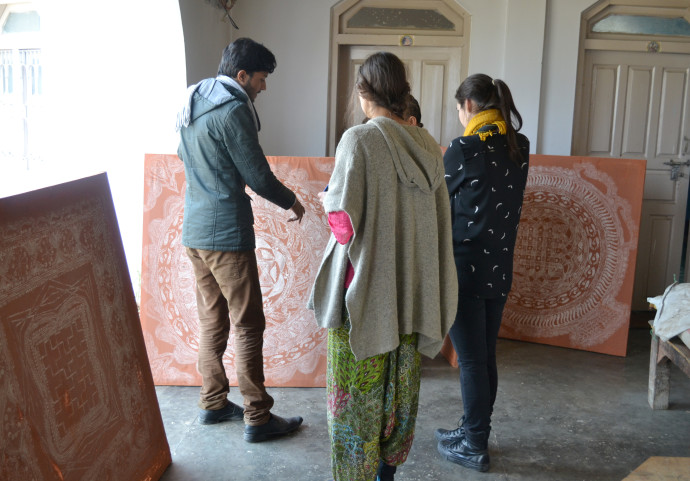
Himanshu Sharma (from left), Nicole Schlosser (Canada) and Julie Parenteau (Canada) admire aipan paintings at the house of Jugal Kishor Paithshali. (Photos by Scott Ponemone)
Here are the four paintings, each with details.
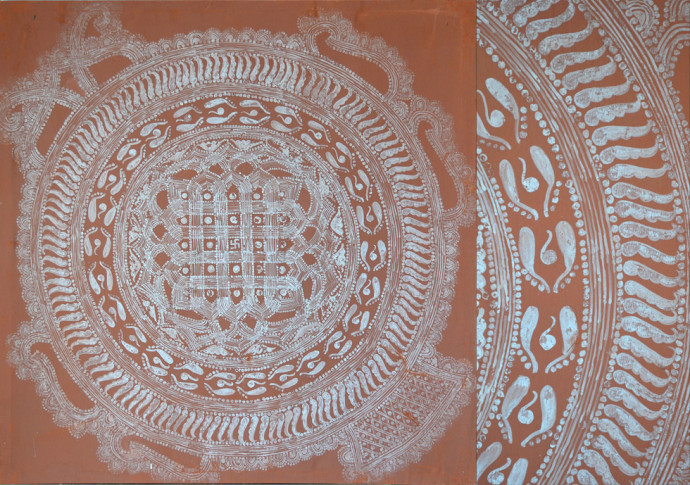
D’source says the central motif is a Chowki design, normally used for seating the idols of gods and goddesses.



When I asked Paithshali about the significance of the aipan dots (done with the touch of a finger tip), he simply said and emphasized that it all begins with the point. From Project Aipan website (https://projectaipan.wordpress.com/category/aipan-art/):
To understand the Aipan art better, it is very important to know the significance of ‘Dots’ in the Aipan designs. A ‘dot’ signifies completeness and life. According to natural science, a dot is like the seed through which the world has originated. Mathematical science also has a special emphasis on the dots. While meditating too, the axis of concentration is none other than a point or ‘dot’. It is thus that a dot is included as an important part of the Aipan art. …
An Aipan without dots is considered inauspicious. On the death of a person, the Aipan is drawn without dots.
The central motif shown of the aipan immediately above is made from a pattern of nine dots square. It’s called a bhadra and is drawn at a place of worship. The number of dots in a bhadra can vary. I practiced making a bhadra like the one above.
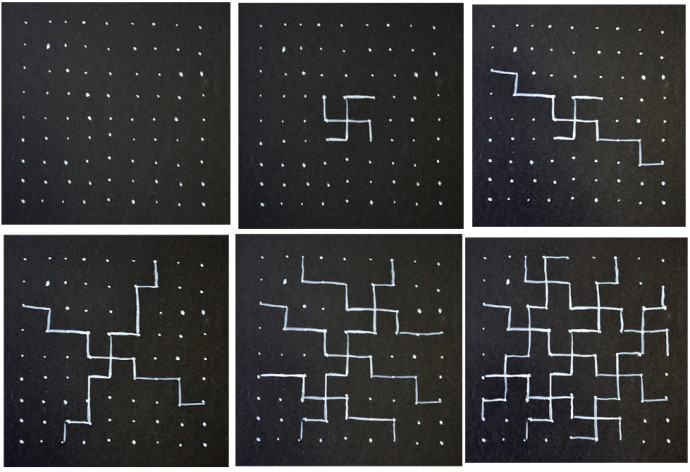
After making the grid, the first step is the central swastik. Now as a Jew, making a swastik requires overcoming great resistance. I need not explain. But it’s impossible to practice aipan without making swastiks. The Uttarakhand Worldwide webstite (http://www.uttaranchal.org.uk/aipan.php ) explains:
Swastik has great significance in Aipan. It is drawn in some form or other during most of the religious rituals as swastik in Hindu mythology represents all Gods and Goddesses, known or unknown. … Swastik represents the creation and progress. All four arms of swastik inspire to move forward. Thus swastik is the symbol of marching ahead for success, towards success with success.
When I first tried to connect the dots in a bhadra, I reproduced a pattern of Christian-like crosses in black defined be white lines. Then I realized that the swastik is formed by two branches. One branch connects three dots horizontally with two legs, going either one dot up or one dot down; the other branch connects three dots vertically with two legs, going either one dot left or one dot right.
The top row, right image shows the horizontal branch extended out. The second row, left adds the vertical branch extended out. The second row, middle image adds two other horizontal branches. As a result two more swastiks are created. The last image adds two vertical branches, and as a consequence six more swastiks.
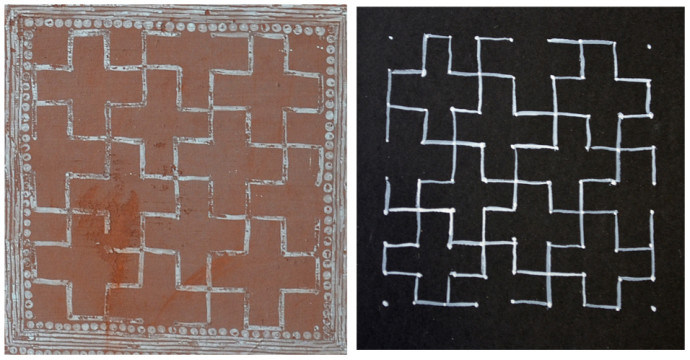
Finally, I connected the last of the dots, leaving the corner dots free. Compare this to the central bhadra of the large aipan at Paithshali’s house.
PRACTICING AIPAN
Before PECAH’s aipan classes begin, I borrow the aipan book from instructor Manav Joshi and make up a circular aipan-like design in watercolor.
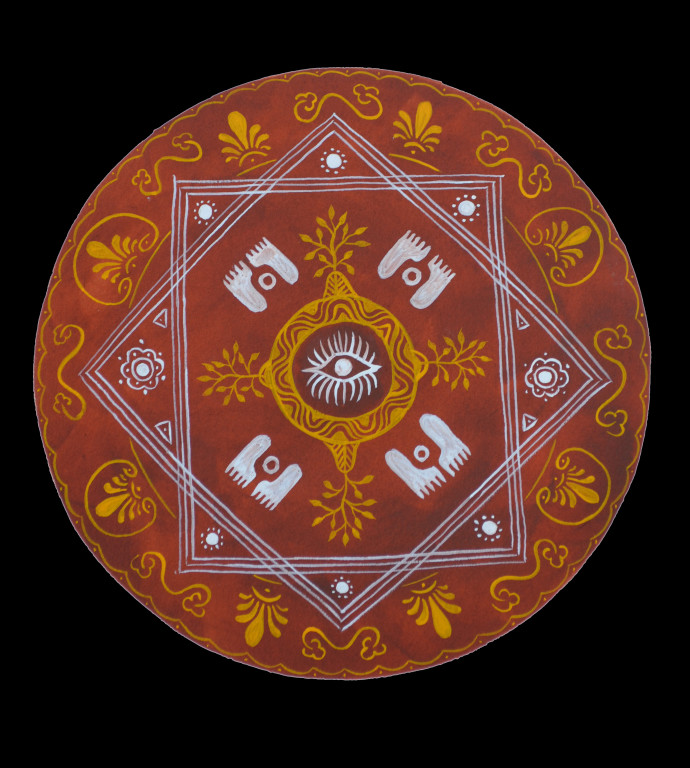
Scott Ponemone, Aipen I, watercolor, 9 3/4″ across, 26 Feb. 2016.
While it mimics the red-brown ground, the triple lines, the paired feet and the use of dots of aipan, this looks more like an East/West amalgam. Note the anthemions from Greek tradition around the rim. Then I get serious.
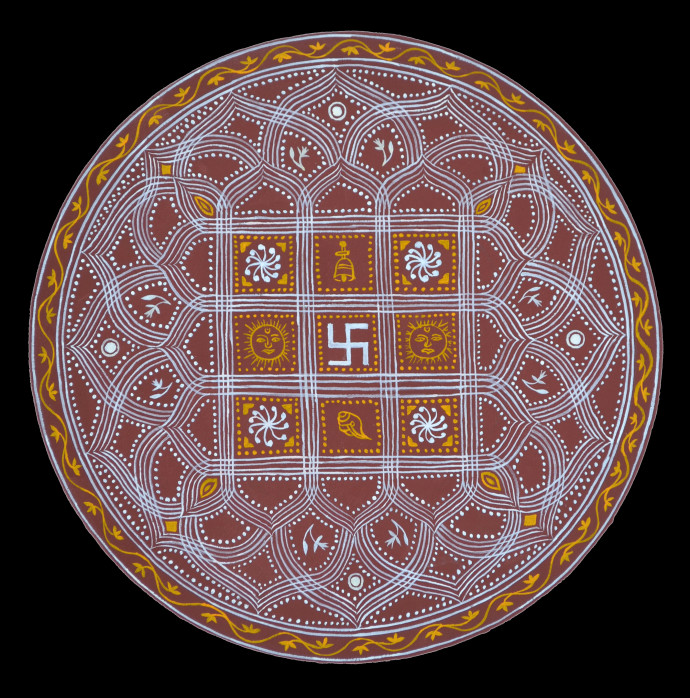
Scott Ponemone, Aipen II, watercolor, 12″ across, 4 March 2016.

Fellow visiting artist Isabel Moreno Cortez (Mexico) photographed me at work.
This took work and concentration. Besides the swastik, I included the sun, moon, bell and shell of aipen tradition. The central motif and all of the pointed arches conform to the Chowki design seen in one of the large aipans at Paithshali’s house, except that I painted four parallel lines instead of five. In internet searches, I now learn that (from Project Aipan website):
Lines also have a special significance. They signify continuity. Odd number of lines is used in Aipan designs. It is believed that even numbers are complete in themselves, but odd numbers are incomplete and seem open-ended. It is suggestive of the wonderful message of continuity and eternity.
 Finally, Manav Joshi starts classes. Part of me thinks: “I’ve done that.” Yet another part of me wants not to be so aloof. What convinces me to join in is that Manav has us connect with the folk tradition of aipan by grinding presoaked rice between two stones (which looked like limestone, perhaps with a history in a cemetery) to make aipan paint.
Finally, Manav Joshi starts classes. Part of me thinks: “I’ve done that.” Yet another part of me wants not to be so aloof. What convinces me to join in is that Manav has us connect with the folk tradition of aipan by grinding presoaked rice between two stones (which looked like limestone, perhaps with a history in a cemetery) to make aipan paint.

With Manav Joshi’s (above) guidance, a PECAH artist grinds rice to make aipan paint. (Photos by Scott Ponemone)
Each aipen student painted a circle with a water-based red-brown paint on the deck of the PECAH hotel near the village of Manila. Then we literally tried our hand at aipen painting. I for one did a pretty miserable job of dipping my fingers in rice paint and attempting to make lines with the tip of my middle finger.
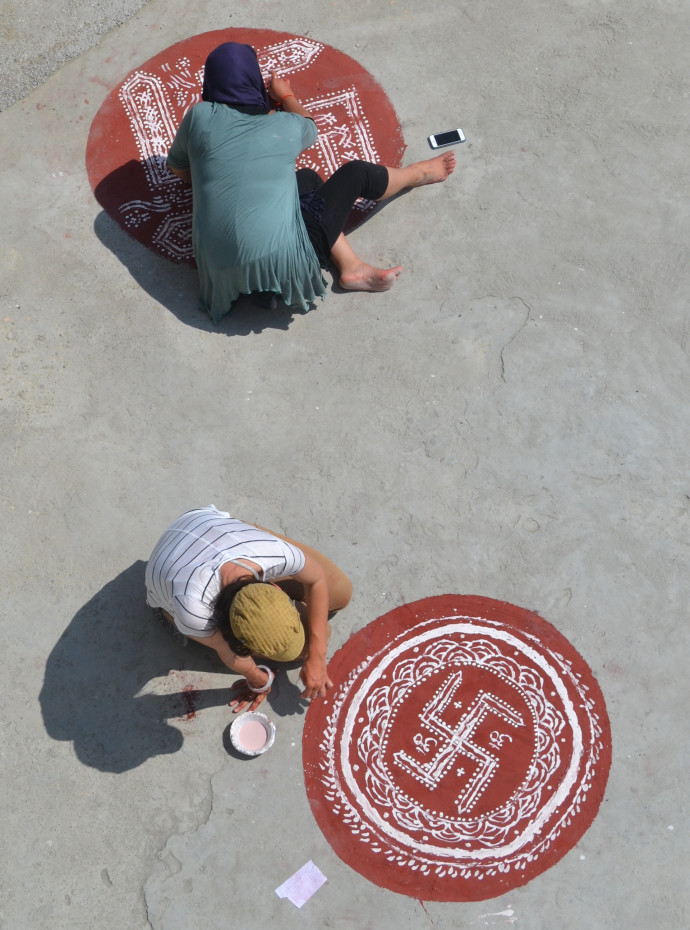
Isabel Moreno Cortez (top) and Julie Parteneau work on their aipens.
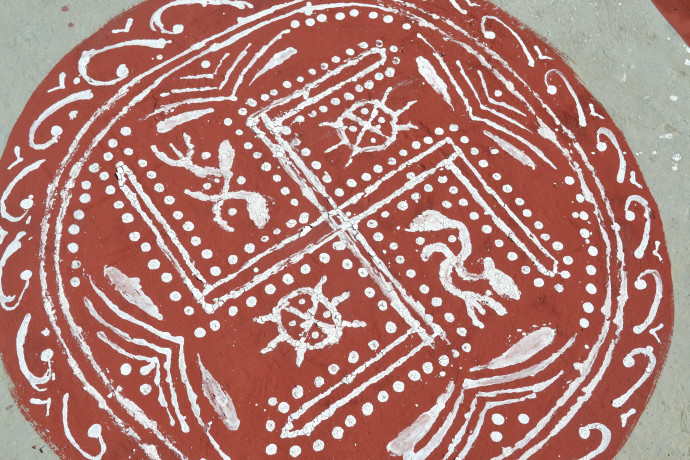
My effort. Pretty rough, no?
AIPAN/PLANETS SYNTHESIS
So much for finger painting. I return to brushes and watercolors to see how I’d do adapting aipan motifs to borders for my sky paintings. I was limited to a 20″ x 14″ Arches watercolor block that fit into my suitcase.

Scott Ponemone, Sky Aipen I, watercolor, 12″ across, 5 March 2016.
After many days without any clouds, a few formed over the Himalayas, which were usually hidden in an inversion of smoke and dust. These became my sky. The aipan border is quite traditional. The problem was that the border overwhelmed the sky. But it was a good start.
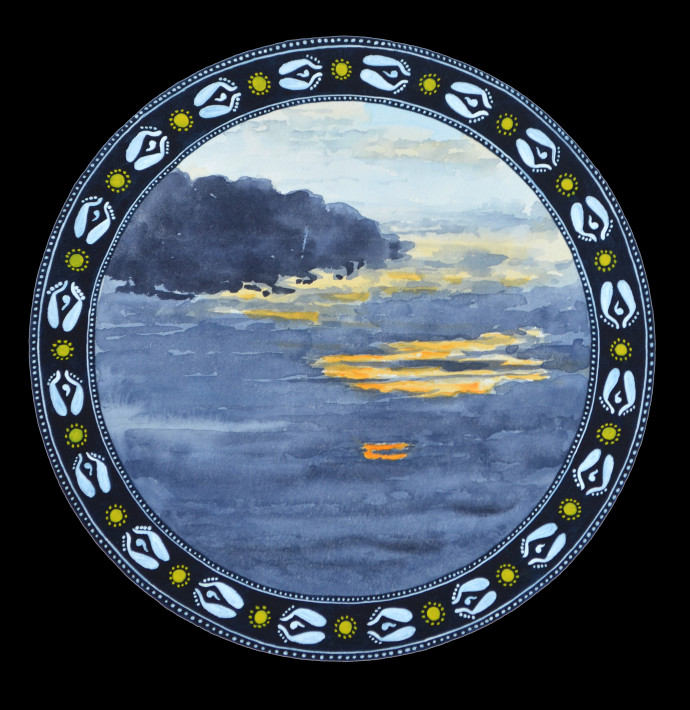
Scott Ponemone, Sky Aipen II, watercolor, 12″ across, 6 March 2016.
An interesting sunrise propelled my second effort. I reduced the border width and changed the background color to indigo. The alternating feet and suns are in the aipan tradition. This, I feel, is a real success.

Scott Ponemone, Sky Aipen III, watercolor, 12″ across, 7 March 2016.
Finally a dramatic, thundery sky. I made the ground magenta. This too is super. Note that these three Sky Aipens were painted on consecutive days, with the third completed on my very last day at the PECAH hotel. I was on a roll, then I suddenly stopped. It was time for the two-day PECAH festival in Ramnagar, the hometown of most of the PECAH instructors. Afterwards, I would take a train to Delhi to deal with my visa problems. But that’s another story.
ADDENDUM
I did attempt a pattachitra painting, using fabric pigments on cotton. The central figures are really just a copy of a line drawing from a book, which also provided the border pattern. But it’s pretty successful in its own right.

Scott Ponemone, Gaja Singha Bidala, pattachitra with fabric paints on cotton, 16″ x 8 3/4″, February 2016.
 Fortunately, Himanchu Sharma, who instructed us on pattachitra, has emailed me with a description of what I depicted:
Fortunately, Himanchu Sharma, who instructed us on pattachitra, has emailed me with a description of what I depicted:
“Gaja means elephant, and Shingha Bidala means lion cat. They represent body and soul: Lion represents our body, and elephant represents our soul. The paintings says that our body controls us in general, where as it should be our body must be controlled by our soul. That is an ideal condition that never comes about. So the artist depicts the practical world instead.”
Himanshu Sharma (Photo by Scott Ponemone) ►
Trackback URL: https://www.scottponemone.com/lessons-in-aipan/trackback/











A fabulous post Scott! Thank you for the introduction to Aipen folk art. I like your first attempt best (Sky Aipen I). I also liked pattachitra painting and the story that Himanchu Sharma provided.
I loved reading your post. How exciting to be in India learning folk art. I loved how you showed step by step with great photographs and the way you applied your new knowledge to clouds at the end. Also, I really liked the rice painting even if it was rough.
And, funny, but I also like your Sky Aipen I the best—something about the sky, I can see the Himalayas there somehow and even though the Aipen border is strong, I still think it is good.
Look forward to reading more .
This is terrific, Scott – one of my favorite of your posts yet.
You know how I admire your skill and perspective as as an artist (and as a wise, great friend in my life). What’s cool here is that I could especially appreciate the the teacher-pedagogue side of you that brings the reader (some of us not terribly learned in how things happen) along for the ride to better understand your efforts just as you’re learning them. It was terrific.
For the record, I too am a huge fan of the Sky Aipen I one too. I see what you mean by the contrast bieng more extreme, but I think that sky is one of my personal favorites.
scott well done its very nice discription of aipen and patachitra and its also honour for me, you are very wise person and I am very glad to i worked with you thank you so much
Really happy to finally discover your blog Scott, it’s really nice ! I’ll come back :) :)
Beautiful post :) I am a Aipan lover from Almora itself. I feel my amazing culture and Himalayas in this post when I am miles away from Almora .
Lots of blessings to u guys :)
Thanks a lot :)